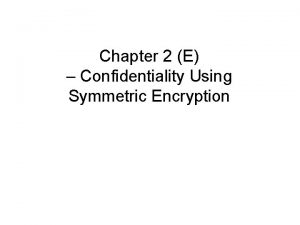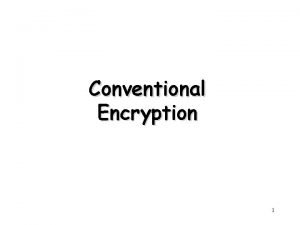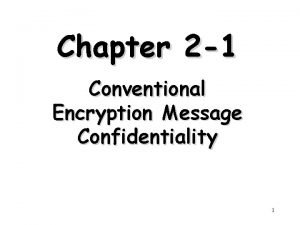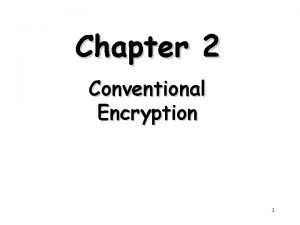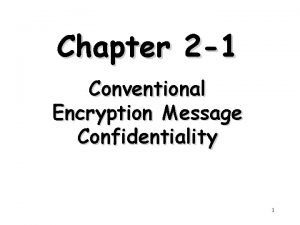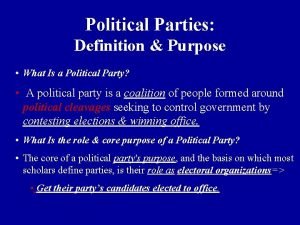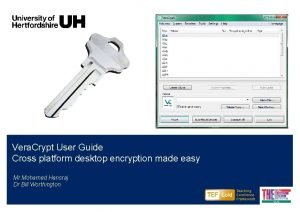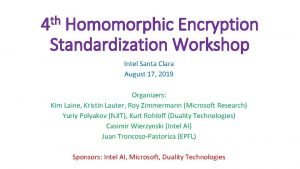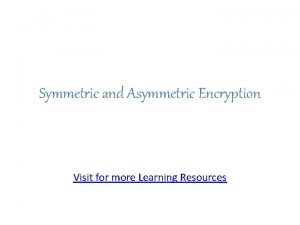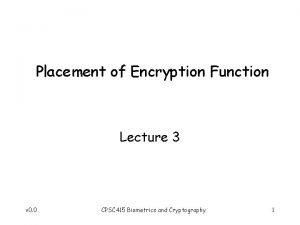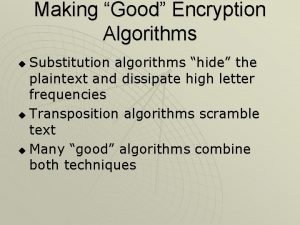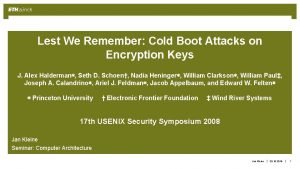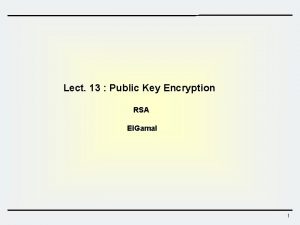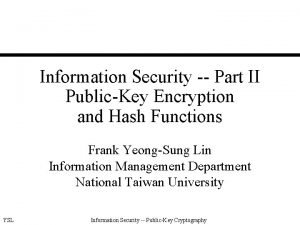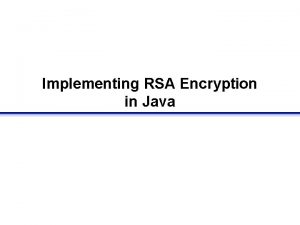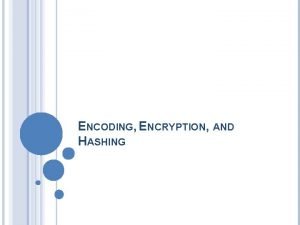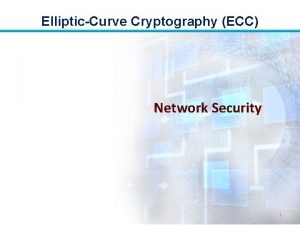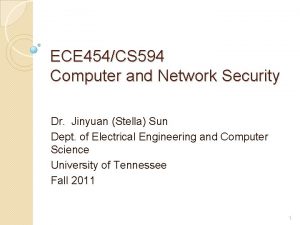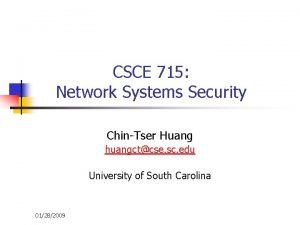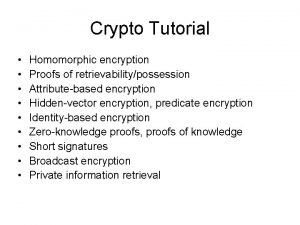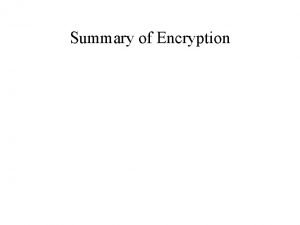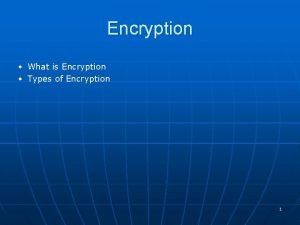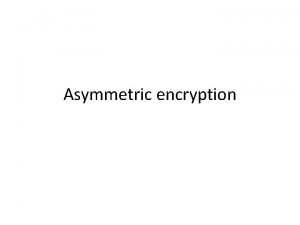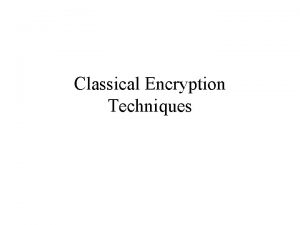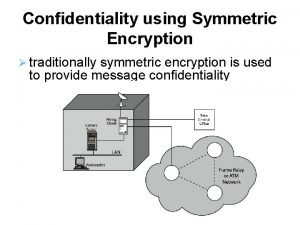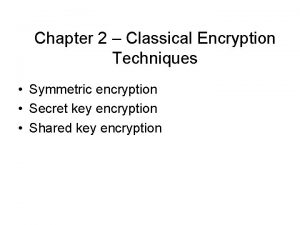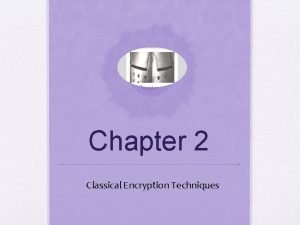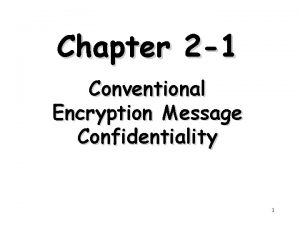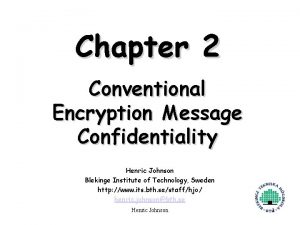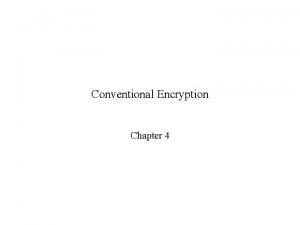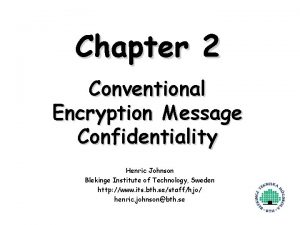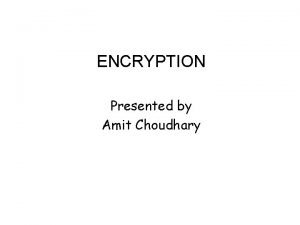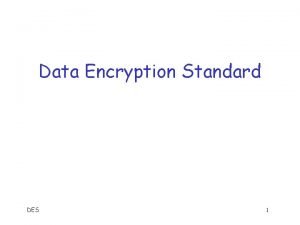CONFIDENTIALY USING CONVENTIONAL ENCRYPTION Chapter 7 Historically Conventional


























- Slides: 26

CONFIDENTIALY USING CONVENTIONAL ENCRYPTION – Chapter 7 • Historically – Conventional Encryption • Recently – Authentication, Integrity, Signature, Public-key • Link • End-to-End • Traffic-Analysis • Key Distribution • Random Number Generation

Points of Vulnerability 2

Link / End-to-End 3

• Link Confidentiality - both ends of link - many encryps / decryps - all links use it - decrypt at packet switch (read addr. ) - unique key / node pair • End- to-End - only at ends - data encrypted, not address (header) - one key pair - traffic pattern insecure - authentication from sender

Characteristics of Link and End-to-End Table 7. 1

Both Link and End-to-End - Data secure at nodes - Authentication • LINK – low level (physical/link) • END-TO-END – network (X. 25) End 0 End 1 End 2 | (ends separately protected)

Front-End Processor Function 7

E-mail Gateway 8

E-mail Gateway OSI email gateway TCP • no end-to-end protocol below appl. layer • networks terminate at mail gateway • mail gateway sets up new transport/network connections • need end-to-end encryp. at appl. Layer - disadvantage: many keys

Various Encryption Strategies 10

Traffic Confidentiality • Identities • Message Frequency • Message Pattern • Event Correlation • Covert Channel Link • Headers encrypted • Traffic padding (Fig 7. 6) End-to-End • Pad data • Null messages

Traffic Padding 12

KEY DISTRIBUTION 1. Physically deliver 2. Third party physically select/deliver 3. EKold(Knew) → 4. 4. End-to-End(KDC): A E (K ) C E (K KA new KB new) B N hosts → (N)choose(2) keys – Fig 7. 7 KDC – Key hierarchy – Fig 7. 8 Session Key – temporary : end ↔ end Only N master keys – physical delivery

#End-to-End Keys 14

Key Hierarchy 15

KEY DISTRIBUTION SCENARIO 16

KEYMaster DISTRIBUTION User shares Key with KDC Steps 1 -3 : Key Distribution Steps 3, 4, 5 : Authentication

Key Distribution Centre (KDC) Hierarchy LOCAL KDCs KDCX KDCA KDCB A B Key selected by KDCA, KDCB, or KDCX

LIFETIME Shorter Lifetime → Highter Security → Reduced Capacity Connection-oriented: - change session key periodically Connectionless: - new key every exchange or #transactions or after time period

Key Distribution (connection-oriented) End-to-End (X. 25, TCP), FEP obtains session keys 20

Decentralised Key Control Not practical for large networks - avoids trusted third party 21

KEY USAGE key types : Data, PIN, File key tags : Session/Master/Encryp/Decryp Control Vector: associate session key with control vector (Fig 7. 12)

Control Vector Encryp. and Decryp. 23

PRNG From Counter 24

ANSI X 9. 17 PRNG 25

Random Number Generation • Linear Congruential Generator Xn+1 = (a. Xn + c) mod m • Encryption : DES (OFB) – (Fig 7. 14) • Blum Shub (BBS) X 0 = s 2 mod n for i = 1 to infinity Xi = (Xi-1)2 mod n Bi = Xi mod 2
 Encryps
Encryps Confidentiality with symmetric encryption
Confidentiality with symmetric encryption Conventional encryption
Conventional encryption Conventional encryption and message confidentiality
Conventional encryption and message confidentiality Conventional encryption
Conventional encryption Conventional encryption model
Conventional encryption model Key distribution center
Key distribution center What is the historical significance
What is the historical significance Two parts that make up most mirrors
Two parts that make up most mirrors Ancient near east countries physical education
Ancient near east countries physical education What is american sign language (asl) (circle 2 answers)
What is american sign language (asl) (circle 2 answers) Historically, realignments occur
Historically, realignments occur Vera crypt
Vera crypt Homomorphic encryption standard
Homomorphic encryption standard Asymmetric key cryptography
Asymmetric key cryptography Placement of encryption function
Placement of encryption function Set-omeconfiguration
Set-omeconfiguration Making good encryption algorithms
Making good encryption algorithms Lest we remember: cold boot attacks on encryption keys
Lest we remember: cold boot attacks on encryption keys Rsa public-key encryption and signature lab solution
Rsa public-key encryption and signature lab solution Public key encryption
Public key encryption Java rsa implementation
Java rsa implementation Encoding encryption and hashing
Encoding encryption and hashing Encryption decrypti
Encryption decrypti Crc encryption
Crc encryption Encryption
Encryption Homomorphic encryption tutorial
Homomorphic encryption tutorial

